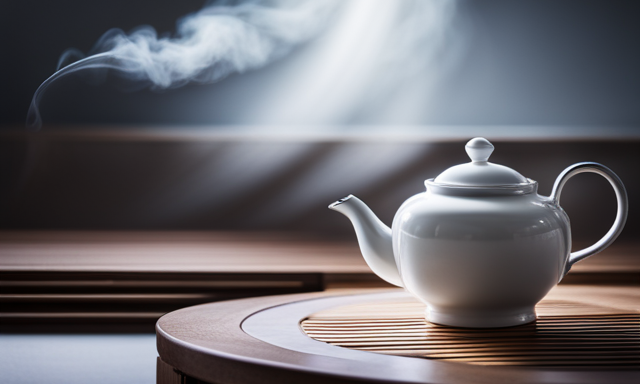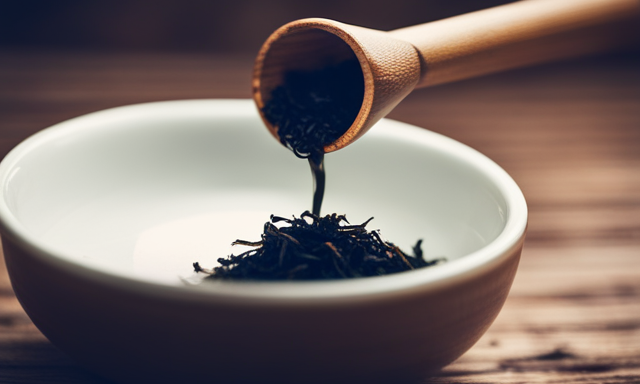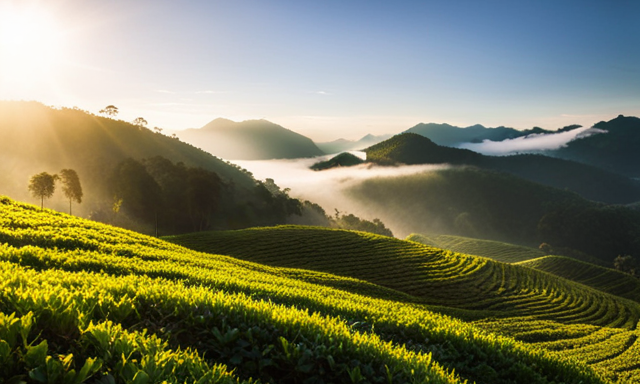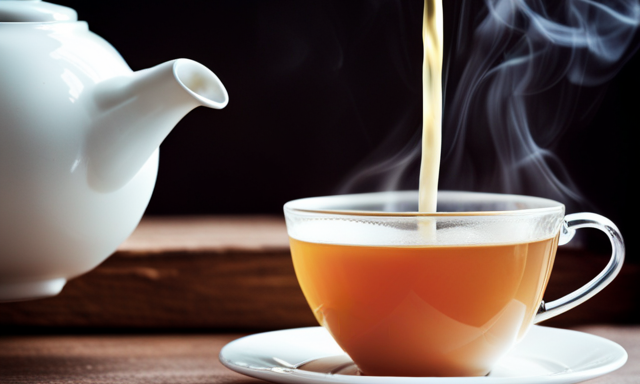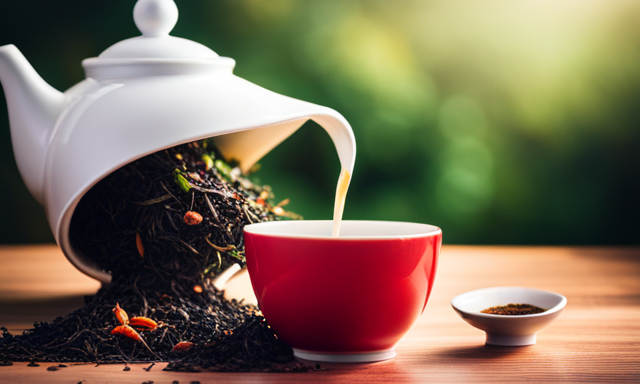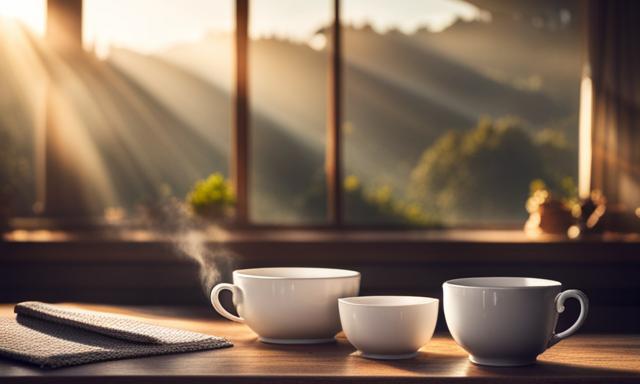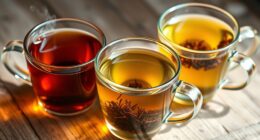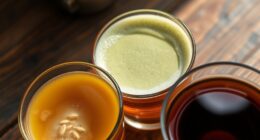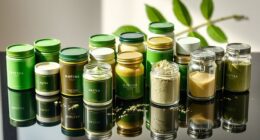Are you ready to embark on a journey of flavor and indulgence? Today, I invite you to join me in the delightful world of oolong milk tea.
This exquisite beverage, with its rich and creamy texture, is the perfect blend of earthy oolong tea and velvety milk. As you take your first sip, a symphony of flavors dances on your taste buds, leaving you with a sense of sheer bliss.
In this article, I will be your guide, revealing the secrets to creating your own oolong milk tea masterpiece. From selecting the finest oolong tea leaves to mastering the art of combining tea and milk, I will share with you all the steps and tips you need to know.
Whether you prefer it sweetened or with a hint of ice, oolong milk tea offers endless possibilities to explore. So, grab your ingredients and equipment, and let’s dive into the world of oolong milk tea, where every sip is a moment of pure indulgence.
Key Takeaways
- Oolong milk tea can be customized with various flavors and ingredients, allowing for a personalized beverage experience.
- The quality of the tea leaves used can significantly impact the taste and overall enjoyment of oolong milk tea.
- Oolong milk tea can be made with different types of milk and sweeteners, providing options for individuals with dietary restrictions or preferences.
- Oolong milk tea is a versatile beverage that can be enjoyed at any time of the day, either as a refreshing drink or a comforting dessert-like treat.
Gather Your Ingredients and Equipment
Now it’s time to gather all the delicious ingredients and equipment you’ll need to create your very own mouthwatering oolong milk tea!
When it comes to choosing the perfect oolong tea for your milk tea, there are several different types to consider. Some popular options include Tie Guan Yin, Da Hong Pao, and Oriental Beauty. Each type has its own unique flavor profile, so feel free to experiment and find your favorite.
Additionally, using fresh ingredients is essential for achieving the best taste. Be sure to use high-quality milk, preferably whole milk, and sweeten with a natural sweetener like honey or sugar.
With the right ingredients and equipment in hand, we can now move on to the next step: brewing the oolong tea.
Brew the Oolong Tea
First, imagine yourself as a skilled alchemist, transforming the delicate leaves into a golden elixir that carries the essence of the mountains. To brew the perfect oolong tea for your milk tea creation, you’ve got various options. There are different types of oolong tea that you can use, each with its own unique flavor profile. Some popular choices include Tie Guan Yin, Da Hong Pao, and Oriental Beauty. Experiment with different types to find your favorite.
Additionally, there are alternative ways to brew oolong tea apart from the traditional method. You can try using a gaiwan, a tea infuser, or a teapot with a built-in strainer. These methods may affect the taste and strength of the tea, so adjust accordingly.
Once your oolong tea is brewed to perfection, you’re ready to move on to preparing the milk mixture.
Prepare the Milk Mixture
Imagine yourself gently heating a combination of creamy milk and sweet condensed milk on the stove, creating a luscious, velvety concoction that will perfectly complement the delicate flavors of the oolong tea.
When preparing the milk mixture for your oolong milk tea, it’s important to choose the right type of milk. Whole milk is the most commonly used, but you can also opt for almond milk or soy milk if you prefer a dairy-free alternative. For a richer and creamier texture, you can even use half-and-half or heavy cream.
To achieve that frothy goodness, there are a few tips to keep in mind. First, make sure to use cold milk, as it froths better than warm milk. You can also consider using a frother or a handheld milk whisk to create more foam. Additionally, gently tapping the milk container on a countertop after frothing can help remove any large bubbles and create a smoother texture.
Now that your milk mixture is perfectly frothed and ready, it’s time to move on to the next step: combining the tea and milk.
Combine the Tea and Milk
Once the milk mixture is frothed to perfection, it’s time to blend it with the aromatic oolong tea. This step is crucial as it brings together the rich creaminess of the milk with the fragrant and earthy flavors of the tea.
When combining the two, you have several options for the type of milk to use in your oolong milk tea. You can choose from traditional cow’s milk, which adds a creamy and indulgent taste, or try alternative non-dairy options like almond milk, coconut milk, or oat milk for a lighter and plant-based twist. Each type of milk brings its own unique flavor profile to the tea, allowing you to customize your drink according to your preferences.
Now that the tea and milk are perfectly blended, it’s time to move on to the next step: adding sweetener (optional).
Add Sweetener (Optional)
To enhance the delightful flavors of your blended concoction, you may want to consider adding a touch of sweetener. This will allow the subtle notes of your tea and milk fusion to be complemented by a gentle hint of sweetness. While sweetener isn’t necessary for oolong milk tea, it can definitely enhance the overall taste experience.
The addition of sweetener can help balance out any bitterness that may be present in the tea. It also provides a pleasant contrast to the creamy texture of the milk. Depending on your personal preference, you can opt for various sweeteners like honey, sugar, or even condensed milk. Experiment with different amounts to find the perfect level of sweetness that suits your taste buds.
Now that your tea and milk are perfectly blended, let’s move on to the next step: adding ice for a refreshing twist.
Add Ice (Optional)
Now that you’ve blended your delightful concoction, consider adding ice for a refreshing twist. Should you add ice to oolong milk tea? Absolutely! Adding ice not only cools down the tea, but it also enhances the overall experience.
The cold temperature of the ice complements the rich and smooth flavor of the oolong milk tea, creating a perfect balance. As the ice melts, it dilutes the tea slightly, mellowing out any bitterness and creating a smoother taste. The chilled tea is incredibly thirst-quenching and perfect for hot summer days or whenever you need a cool, revitalizing beverage.
So go ahead and add some ice to your oolong milk tea, and get ready to enjoy a refreshing and delicious drink. Now, let’s move on to the next step: shake or stir.
Shake or Stir
For the best results, consider shaking or stirring your oolong milk tea to ensure all the flavors are well combined. When it comes to shaking or stirring, it ultimately depends on your personal preference.
Shaking the tea vigorously in a cocktail shaker will create a frothy and slightly creamy texture, while stirring with a spoon will result in a smoother and more delicate taste. Both methods will effectively blend the oolong tea with the milk and sweetener, allowing the flavors to meld together harmoniously.
As for the best type of oolong tea to use for milk tea, a lightly roasted or semi-oxidized oolong works best. These types of oolong teas have a balanced flavor profile that complements the creaminess of the milk.
Now, let’s move on to the next section, where we’ll learn how to serve and enjoy your homemade oolong milk tea.
Serve and Enjoy
Indulge in the velvety embrace of a perfectly crafted cup of creamy oolong goodness, and savor every sip of pure tea bliss. Now that your oolong milk tea is ready, it’s time to serve and enjoy this delightful beverage.
There are several ways to enhance the flavor of your oolong milk tea. For a touch of sweetness, you can add a drizzle of honey or a sprinkle of cinnamon. If you prefer a more indulgent treat, a dollop of whipped cream or a sprinkle of cocoa powder can elevate the taste. Different serving suggestions include pouring the tea over ice for a refreshing iced version, or adding a splash of almond milk for a nutty twist. Experiment with variations to find your perfect combination of flavors.
Transitioning into the next section, let’s explore how to take your oolong milk tea to the next level by adding unique ingredients.
Experiment with Variations
Get ready to elevate your oolong milk tea experience by experimenting with unique flavor combinations and ingredients.
One way to switch up your oolong milk tea is by trying different types of oolong teas. Each variety of oolong tea has its own distinct flavor profile, ranging from floral and fruity to toasty and nutty. Some popular options include Tie Guan Yin, Da Hong Pao, and Oriental Beauty.
Incorporating different flavors into your oolong milk tea is another great way to add a personal touch. You can use flavored syrups like vanilla, caramel, or hazelnut, or even experiment with fresh ingredients like ginger, mint, or citrus zest.
By exploring different oolong teas and experimenting with unique flavors, you can create a truly customized and delicious oolong milk tea that suits your taste preferences perfectly.
Frequently Asked Questions
How long does it take to brew the oolong tea?
Brewing oolong tea to perfection depends on various factors. The brewing time can vary from 2-5 minutes, depending on the desired strength. Factors like water temperature, tea leaves quality, and personal preference can affect the brewing time.
Can I use any type of milk for the milk mixture?
Yes, you can use different types of milk for the milk mixture in oolong tea. Some alternatives to using milk include almond milk, coconut milk, or soy milk, which can add unique flavors to your tea.
What kind of sweeteners can I use in the oolong milk tea?
For a personalized touch, a variety of natural sweeteners can be added to oolong milk tea. Additionally, experimenting with different tea leaves suitable for milk tea and making a homemade sweetened condensed milk substitute can enhance the flavor.
Is it necessary to add ice to the oolong milk tea?
Adding ice to oolong milk tea offers several benefits. It helps to cool down the drink, making it refreshing and perfect for hot weather. Additionally, the ice dilutes the tea slightly, creating a milder taste that some people prefer.
Are there any alternative methods to shake or stir the tea and milk together?
To mix tea and milk without shaking or stirring, alternative methods include using a blender or frother. These tools create a smooth and well-mixed oolong milk tea by blending the tea and milk together for a consistent and delicious beverage.
Conclusion
In conclusion, making your own oolong milk tea is a simple and rewarding process. By gathering the necessary ingredients and equipment, brewing the tea, preparing the milk mixture, and combining them together, you can create a delicious and refreshing beverage.
Whether you prefer it sweetened or with ice, it’s up to you to experiment and find your perfect variation. So why not give it a try? Making oolong milk tea is as easy as a walk in the park, and as satisfying as sipping on a cool breeze on a sunny day.

